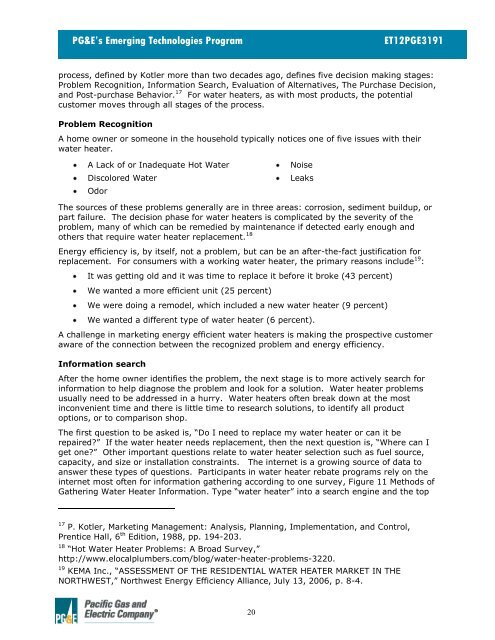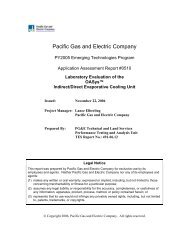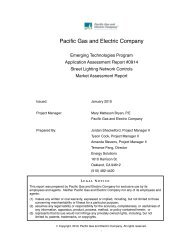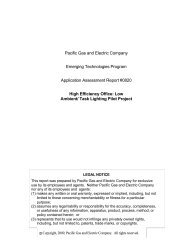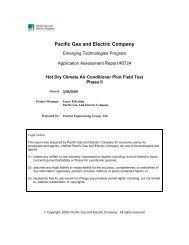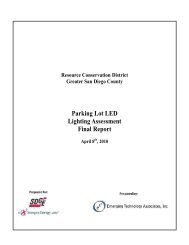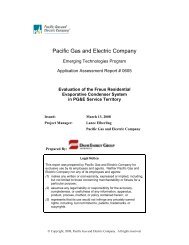PGE Water Heater ET Final Report - FINAL.pdf - Emerging ...
PGE Water Heater ET Final Report - FINAL.pdf - Emerging ...
PGE Water Heater ET Final Report - FINAL.pdf - Emerging ...
You also want an ePaper? Increase the reach of your titles
YUMPU automatically turns print PDFs into web optimized ePapers that Google loves.
PG&E’s <strong>Emerging</strong> Technologies Program <strong>ET</strong>12<strong>PGE</strong>3191<br />
process, defined by Kotler more than two decades ago, defines five decision making stages:<br />
Problem Recognition, Information Search, Evaluation of Alternatives, The Purchase Decision,<br />
and Post-purchase Behavior. 17 For water heaters, as with most products, the potential<br />
customer moves through all stages of the process.<br />
Problem Recognition<br />
A home owner or someone in the household typically notices one of five issues with their<br />
water heater.<br />
A Lack of or Inadequate Hot <strong>Water</strong> Noise<br />
Discolored <strong>Water</strong> Leaks<br />
Odor<br />
The sources of these problems generally are in three areas: corrosion, sediment buildup, or<br />
part failure. The decision phase for water heaters is complicated by the severity of the<br />
problem, many of which can be remedied by maintenance if detected early enough and<br />
others that require water heater replacement. 18<br />
Energy efficiency is, by itself, not a problem, but can be an after-the-fact justification for<br />
replacement. For consumers with a working water heater, the primary reasons include 19 :<br />
It was getting old and it was time to replace it before it broke (43 percent)<br />
We wanted a more efficient unit (25 percent)<br />
We were doing a remodel, which included a new water heater (9 percent)<br />
We wanted a different type of water heater (6 percent).<br />
A challenge in marketing energy efficient water heaters is making the prospective customer<br />
aware of the connection between the recognized problem and energy efficiency.<br />
Information search<br />
After the home owner identifies the problem, the next stage is to more actively search for<br />
information to help diagnose the problem and look for a solution. <strong>Water</strong> heater problems<br />
usually need to be addressed in a hurry. <strong>Water</strong> heaters often break down at the most<br />
inconvenient time and there is little time to research solutions, to identify all product<br />
options, or to comparison shop.<br />
The first question to be asked is, “Do I need to replace my water heater or can it be<br />
repaired?” If the water heater needs replacement, then the next question is, “Where can I<br />
get one?” Other important questions relate to water heater selection such as fuel source,<br />
capacity, and size or installation constraints. The internet is a growing source of data to<br />
answer these types of questions. Participants in water heater rebate programs rely on the<br />
internet most often for information gathering according to one survey, Figure 11 Methods of<br />
Gathering <strong>Water</strong> <strong>Heater</strong> Information. Type “water heater” into a search engine and the top<br />
17 P. Kotler, Marketing Management: Analysis, Planning, Implementation, and Control,<br />
Prentice Hall, 6 th Edition, 1988, pp. 194-203.<br />
18 “Hot <strong>Water</strong> <strong>Heater</strong> Problems: A Broad Survey,”<br />
http://www.elocalplumbers.com/blog/water-heater-problems-3220.<br />
19 KEMA Inc., “ASSESSMENT OF THE RESIDENTIAL WATER HEATER MARK<strong>ET</strong> IN THE<br />
NORTHWEST,” Northwest Energy Efficiency Alliance, July 13, 2006, p. 8-4.<br />
20


